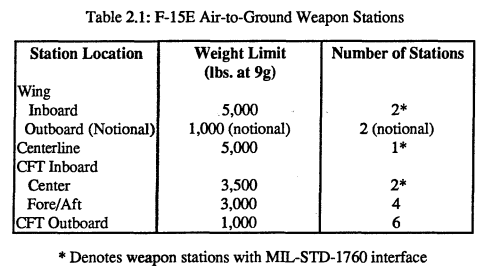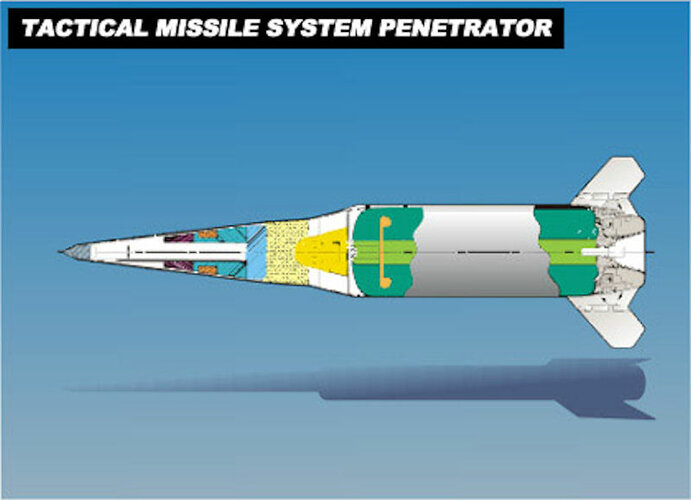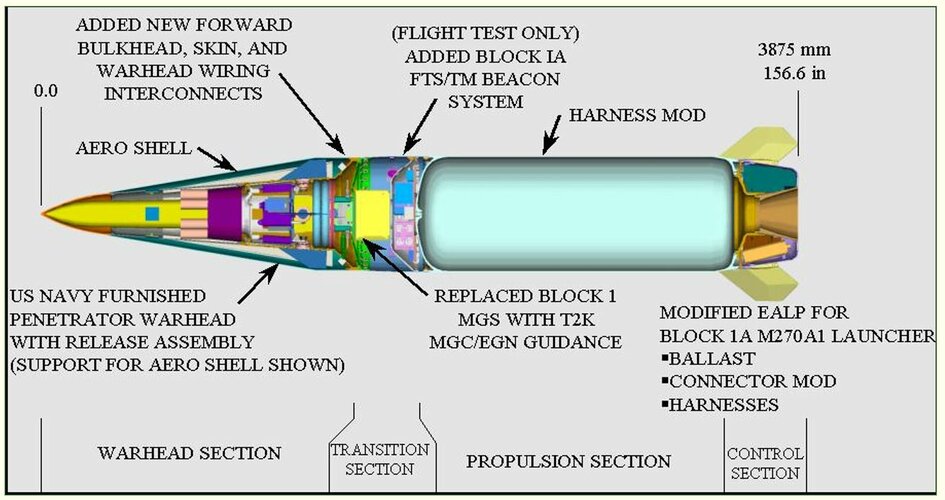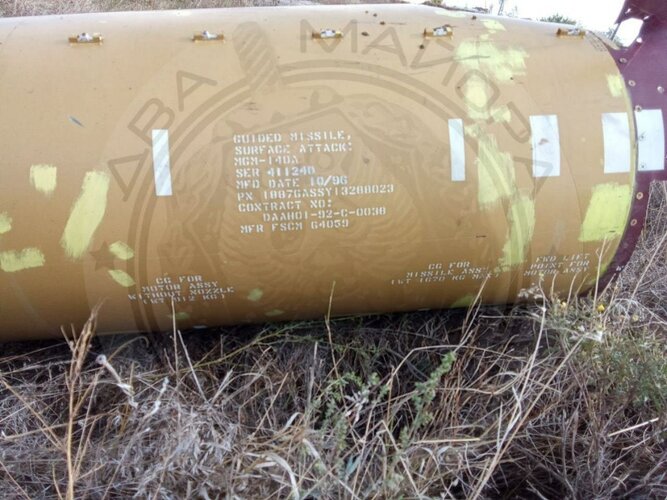You are using an out of date browser. It may not display this or other websites correctly.
You should upgrade or use an alternative browser.
You should upgrade or use an alternative browser.
Vought JTACMS/ATACMS (MGM-140)
- Thread starter Triton
- Start date
- Joined
- 16 April 2008
- Messages
- 8,403
- Reaction score
- 10,374
IIRC only the SADARM and BLU-108 went into production.
BAT evolved into the laser-guided Viper Strike. Not sure if that counts.
BAT evolved into the laser-guided Viper Strike. Not sure if that counts.
I don't know however this is the first time I've heard of the Viper Strike.
- Joined
- 16 April 2008
- Messages
- 8,403
- Reaction score
- 10,374
BAT evolved into the laser-guided Viper Strike. Not sure if that counts.
I don't know however this is the first time I've heard of the Viper Strike.
I was surprised to discover that more than 1100 BAT were made in pre-production/low-rate production. A lot were expended in testing but there were quite a few left to convert.
Last edited:
I was surprised to discover that more than 1100 BAT were made in pre-production/low-rate production.
Wow! That's a lot of preproduction rounds, I was under the impression it never got past the prototype stage.
chimeric oncogene
ACCESS: Secret
- Joined
- 23 May 2019
- Messages
- 295
- Reaction score
- 285
Holy hell that is an impressive picture
All the brilliant goodies of the late 80s and all the might have beens on one dispenser!
Forest Green
ACCESS: Above Top Secret
- Joined
- 11 June 2019
- Messages
- 5,138
- Reaction score
- 6,788
Does ATACMS have an independent warhead, or is it all one piece?
- Joined
- 3 June 2011
- Messages
- 17,339
- Reaction score
- 9,085
All one piece. (Unless it's a model that ejects submunitions.)Does ATACMS have an independent warhead, or is it all one piece?
Does ATACMS have an independent warhead, or is it all one piece?
All those still in service are unitary 500lb Harpoon warheads that do not separate from the motor.
Forest Green
ACCESS: Above Top Secret
- Joined
- 11 June 2019
- Messages
- 5,138
- Reaction score
- 6,788
Anyone know whether PrSM is the same or different in that respect?
Anyone know whether PrSM is the same or different in that respect?
Two hundred pound warhead with preformed fragments of varying sizes. I’m pretty sure they 3D print the casing. It doesn’t separate from the motor.
- Joined
- 3 June 2011
- Messages
- 17,339
- Reaction score
- 9,085
Same.Anyone know whether PrSM is the same or different in that respect?
- Joined
- 3 June 2011
- Messages
- 17,339
- Reaction score
- 9,085
Burn time is about 30 seconds. (Based on one of the X-51 flights.)I was looking up details on the MGM-140's propulsion system but I haven't found out much so I was wondering does anyone know what the thrust and burn time of the rocket-motor is?
Not sure if this has been posted before :
"Adaptation of the Army Tactical Missile System to Undersea Operations"
"Adaptation of the Army Tactical Missile System to Undersea Operations"
From this, pages 212

ATACMS propellant was 640kg
Jane's strategic weapons systems : Lennox, Duncan : Free Download, Borrow, and Streaming : Internet Archive
Jane's Strategic Weapon Systems Issue 38 (2003)
archive.org
ATACMS propellant was 640kg
Voltzz
ACCESS: Secret
- Joined
- 10 April 2021
- Messages
- 368
- Reaction score
- 1,228
There was an experimental ATACMS variant using a modified Mk 4 reentry vehicle from the TRIDENT ballistic missile for penetrating hardened targets. It was called TACMS-P.Does ATACMS have an independent warhead, or is it all one piece?
From Janes:
The TACtical Missile System Penetrator (TACMS-P) uses ATACMS missiles to carry a hard target penetrating warhead, and this was originally known as the Block 3 missile. This development programme is being supported by the US Army and US Navy, and integrates a modified UGM-96 Trident C-4 SLBM Mk 4 re-entry vehicle containing a conventional HE warhead with the ATACMS Block 1A missile. The modified RV will have a guidance and control system fitted, to change the trajectory in space and following re-entry. Other warheads may be considered for this version, which is planned to have a maximum range of 300 km. A further design was considered, extending the range of the TACMS-P missile to nearly 500 km.
From Sandia National Laboratories:
Not sure if the EPW is still based on the MK 4.Tactical Missile System-Penetrator (TACMS-P), an accelerated three-year project, integrates an Army TACMS booster developed by Lockheed Martin with a Navy Strategic Systems Program (SSP) maneuvering reentry vehicle that was designed, developed, and tested by Sandia.
Sandia was chosen to build the integrated Earth Penetrating Warhead (EPW) based on the Labs’ proven expertise in high-speed flight system design, precision navigation, guidance, control capabilities, and penetrator technology, says David Keese (15404), Deputy Director of Aerospace Systems Development Center 15400.
[...]
The TACMS-P was fired from a Multiple Launch Rocket System (MLRS) M270A1 launcher at Launch Complex 33, and flew to a pre-determined altitude and speed to separate the EPW from the booster.
After separation, the booster locked its fins and continued on a ballistic path while the EPW used its movable fins to guide it to a fixed, hard target using a navigation, guidance, and control system developed at Sandia.
Attachments
Scott Kenny
ACCESS: Above Top Secret
- Joined
- 15 May 2023
- Messages
- 6,041
- Reaction score
- 4,906
I believe the EPW MARV is still kicking around.This is the first time I've heard of the TACMS-P and I hope something like it is implemented in the near future.
I believe the EPW MARV is still kicking around.
Got any links?
Christopher Wang
ACCESS: Confidential
- Joined
- 3 June 2021
- Messages
- 131
- Reaction score
- 244
According to Kopp (1985) in "F-15E - Anatomy of Strike Fighter" ( https://www.ausairpower.net/TE-F-15E-Strike-Eagle.html ), the F-15E Strike Eagle was projected to carry up to five JTACMS. Depending on the warhead, the current ATACMS weight in the range from 2910 to 3690 lbs. As illustrated below by King (1995), each of the F-15E Strike Eagle's weapon stations, including the unused outboard wing stations, was stressed for the following capacity:

SOURCE: King, D. R. (1995). A Review of Fighter Aircraft Capability for Smart Bombs. Retrieved from https://apps.dtic.mil/sti/tr/pdf/ADA300588.pdf
Thus, the F-15E Strike Eagle could have carried two JTACMS / ATACMS under the inboard wing stations, one under the centerline station, and two more under the inboard CFT stations.

SOURCE: King, D. R. (1995). A Review of Fighter Aircraft Capability for Smart Bombs. Retrieved from https://apps.dtic.mil/sti/tr/pdf/ADA300588.pdf
Thus, the F-15E Strike Eagle could have carried two JTACMS / ATACMS under the inboard wing stations, one under the centerline station, and two more under the inboard CFT stations.
Got any links?
I believe he is referring to an earth penetrating warhead for Pershing 2.
Scott Kenny
ACCESS: Above Top Secret
- Joined
- 15 May 2023
- Messages
- 6,041
- Reaction score
- 4,906
Links, no, been a while since I last looked.Got any links?
Though I believe that the EPW was not just vetted for the Pershing 2, but ATACMs and maybe Conventional Trident before someone had a sudden outbreak of common sense.
Forest Green
ACCESS: Above Top Secret
- Joined
- 11 June 2019
- Messages
- 5,138
- Reaction score
- 6,788
What is the range of cluster warhead versions of ATACMS?
All versions besides the original M39 are listed at 300km on wiki.
All versions besides the original M39 are listed at 300km on wiki.
- Joined
- 16 April 2008
- Messages
- 8,403
- Reaction score
- 10,374
Wiki does actually list the range of all the variants. But beyond that, a quick web search will find the Army's info page, with the same info.What is the range of cluster warhead versions of ATACMS?
All versions besides the original M39 are listed at 300km on wiki.
Last edited:
Firefinder
ACCESS: Top Secret
- Joined
- 5 October 2019
- Messages
- 790
- Reaction score
- 1,270
The Atacms as an AWHOLE is an INF treaty complianant missile.
By design it limited to the 300km mark to be treaty complainant, might be able to gain maybe another 50km at most by some rejiggling of the flight program but by design that is made to be hard to do.
By design it limited to the 300km mark to be treaty complainant, might be able to gain maybe another 50km at most by some rejiggling of the flight program but by design that is made to be hard to do.
- Joined
- 16 April 2008
- Messages
- 8,403
- Reaction score
- 10,374
The Atacms as an AWHOLE is an INF treaty complianant missile.
By design it limited to the 300km mark to be treaty complainant, might be able to gain maybe another 50km at most by some rejiggling of the flight program but by design that is made to be hard to do.
The initial (non-GPS) ATACMS didn't even max-out the INF range. They added GPS and hacked the payload way back to hit 300km. If they had tried to get more range than that, there would be basically zero payload left.
Forest Green
ACCESS: Above Top Secret
- Joined
- 11 June 2019
- Messages
- 5,138
- Reaction score
- 6,788
Or apply the guidance system to a Hrim-2.The simple way of extending the ATACMS's range would be to do @sferrin 's suggestion (Albeit at the expense of a bigger missile needing a new launcher) and make a two-stage version (The first-stage being a modified ATACMS propulsion section with a boost only grain), call it ATACMS-ER.
timmymagic
Forever disappointed in MoD procurement...
- Joined
- 23 August 2011
- Messages
- 1,056
- Reaction score
- 2,804
Looks like ATACMS has arrived in Ukraine....
Overnight strikes on Russian helicopter bases at Berdyansk and Luhansk with large casualties in aircrat, materiel and personnel.
Speculation that it could be Tochka U, ATACMS or GLSDB seems to be dispelled by this...M74 submunition from M39 or M39A1.
View: https://twitter.com/bayraktar_1love/status/1714243569903448523
Overnight strikes on Russian helicopter bases at Berdyansk and Luhansk with large casualties in aircrat, materiel and personnel.
Speculation that it could be Tochka U, ATACMS or GLSDB seems to be dispelled by this...M74 submunition from M39 or M39A1.
View: https://twitter.com/bayraktar_1love/status/1714243569903448523
Forest Green
ACCESS: Above Top Secret
- Joined
- 11 June 2019
- Messages
- 5,138
- Reaction score
- 6,788
ATACMS with cluster warhead seems to be the consensus. Made quite the mess.
View: https://twitter.com/front_ukrainian/status/1714198438697369908?s=20
View: https://twitter.com/astraiaintel/status/1714269693538673102?s=20
View: https://twitter.com/front_ukrainian/status/1714198438697369908?s=20
View: https://twitter.com/astraiaintel/status/1714269693538673102?s=20
Last edited:
aonestudio
I really should change my personal text
- Joined
- 11 March 2018
- Messages
- 2,546
- Reaction score
- 5,974
Forest Green
ACCESS: Above Top Secret
- Joined
- 11 June 2019
- Messages
- 5,138
- Reaction score
- 6,788
The U.S. Navy's programs to adapt the AGM-140 family of missiles for deployment from surface vessels and submarines.
Scott Kenny
ACCESS: Above Top Secret
- Joined
- 15 May 2023
- Messages
- 6,041
- Reaction score
- 4,906
Absolutely amazing that they managed to stuff that 24" missile into a submarine VLS launch tube designed for 21" weapons.The U.S. Navy's programs to adapt the AGM-140 family of missiles for deployment from surface vessels and submarines.
Kat Tsun
I really should change my personal text
- Joined
- 16 June 2013
- Messages
- 1,127
- Reaction score
- 1,260
Absolutely amazing that they managed to stuff that 24" missile into a submarine VLS launch tube designed for 21" weapons.
A Mk41 would be funny. Tissue paper thin canister walls. The missile has to race out of the tube before the collapsing aluminum crushes it. An Indiana Jones scene every time an FC slaps the TLAM console. 8% chance the VLS causes a fire or the rocket explodes in tube and blows the bow off every time it fires.
TMs just have to grease the cans with KY Jelly to get them to fit.
Last edited:
Forest Green
ACCESS: Above Top Secret
- Joined
- 11 June 2019
- Messages
- 5,138
- Reaction score
- 6,788
Dubious claims of a shootdown but zero AD damage and that bit falls anyway.
View: https://twitter.com/astraiaintel/status/1717419845195624884?s=20
View: https://twitter.com/astraiaintel/status/1717419845195624884?s=20
I think the claim is bullshit, if you look at the rocket-motor you can clearly see the mounting ring for attaching the payload which was submunitions so this ATACMS successfully released its' payload the question is what was its' target?
bring_it_on
I really should change my personal text
- Joined
- 4 July 2013
- Messages
- 3,123
- Reaction score
- 2,240
The seeker equipped variant of the PrSM (existing PrSm with a seeker) is expected to achieve EOC in the FY27-28 timeframe. The longer ranged variant probably in the early 2030s. By that time, it would probably be better to figure out and develop a VLS launched variant of the Navy's HALO Air Launched hypersonic weapon.That’s what LRASM used. PrSM also is going to ultimately have a terminal seeker for moving targets, so there would be some big advantages to adoption.
That might also allow the army to adopt the boosted version for its MRC mission in place of much more expensive SM-6; it’s a mk41 compatible launcher.
Scott Kenny
ACCESS: Above Top Secret
- Joined
- 15 May 2023
- Messages
- 6,041
- Reaction score
- 4,906
There's a good argument that you should have both hypersonic (or at least high supersonic, Mach 4-6) missiles and LO subsonic cruise missiles in inventory. They do different tasks. Need a target smashed RIGHT NOW? Hypersonic all the way. Need to be sneaky? Hypersonics are anything but sneaky, use the LO subsonics.The seeker equipped variant of the PrSM (existing PrSm with a seeker) is expected to achieve EOC in the FY27-28 timeframe. The longer ranged variant probably in the early 2030s. By that time, it would probably be better to figure out and develop a VLS launched variant of the Navy's HALO Air Launched hypersonic weapon.
The seeker equipped variant of the PrSM (existing PrSm with a seeker) is expected to achieve EOC in the FY27-28 timeframe. The longer ranged variant probably in the early 2030s. By that time, it would probably be better to figure out and develop a VLS launched variant of the Navy's HALO Air Launched hypersonic weapon.
No argument, if the program is successful and it can be so adapted. It remains to be seen what kind of propulsion method HALO will use. If it uses a rocket or a hybrid Ram/Scramjet, it might well be amenable to surface launch with a Mk72.
Similar threads
-
-
North American ESO-7618 ("Jet T-28") to spec OS-141 (VTB Basic Jet Trainer)
- Started by Mark Nankivil
- Replies: 52
-
Hughes Aircraft Company XAAM-N-11 model
- Started by Triton
- Replies: 0
-
Robert McCall space plane concept
- Started by Triton
- Replies: 5
-



